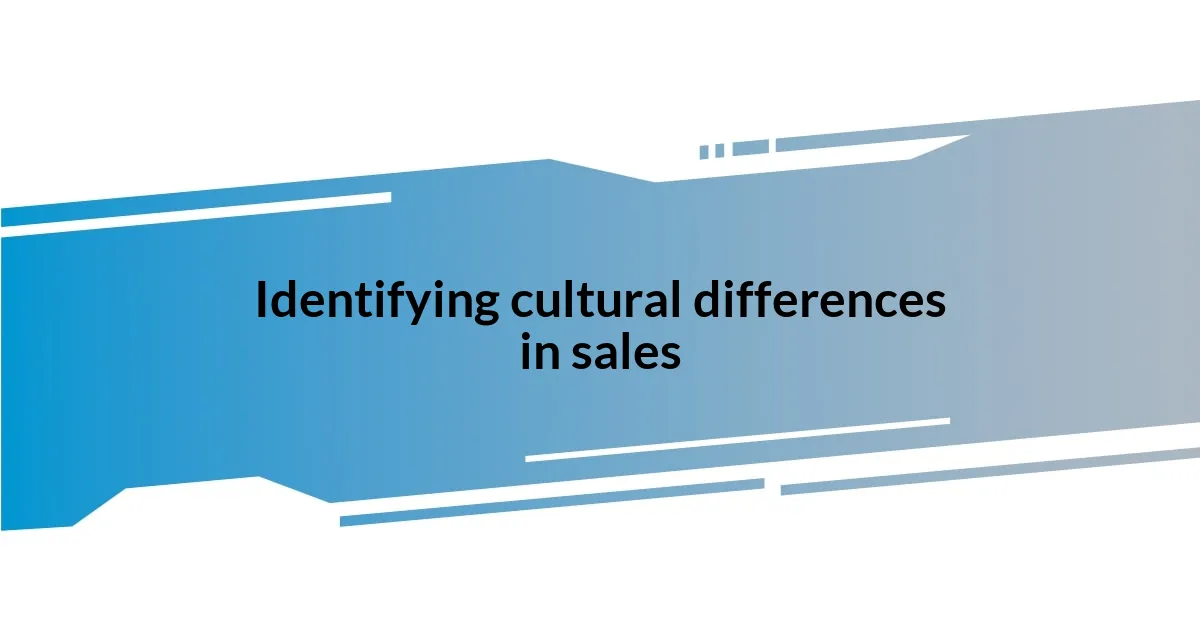Key takeaways:
- Understanding cultural nuances is crucial for global sales success; humor and messaging must be tailored to resonate with diverse audiences.
- Effective sales materials require ongoing adaptations, including localized content, storytelling, and design elements to engage various markets.
- Continuous improvement through metrics, feedback, and collaboration with local teams helps refine strategies and keep them relevant to audience needs.

Understanding global sales adaptation
Understanding global sales adaptation is crucial for any business aiming to reach diverse markets. There was a time when I launched a product in Europe without adjusting the messaging; I quickly realized that humor, which works wonders in the US, fell flat overseas. This experience taught me that cultural nuances can significantly impact how sales materials are perceived.
I often wonder how much specific adaptations can turn a lackluster campaign into a thriving success. For instance, I remember tweaking a brochure for a Latin American audience by emphasizing community and family, which resonated deeply. The shift not only improved engagement but reinforced my belief in the power of understanding your audience’s values and preferences.
Global sales adaptation isn’t just about translation; it’s about transformation. When I worked on materials for the Asian market, I was struck by the need to respect local customs and communication styles. This experience underscored the importance of being sensitive to cultural contexts—not just to sell, but to genuinely connect with potential customers.

Identifying cultural differences in sales
When diving into the cultural aspects of sales, I’ve found that identifying differences can make or break a campaign. For example, while working with a team on a project aimed at the Middle Eastern market, I learned that business etiquette isn’t just a formality; it’s a relationship-building tool. The nuances of greeting styles and the importance of building trust before diving into business conversations became crucial insights that reshaped our approach.
Here’s a quick checklist of cultural differences that can impact sales strategies:
- Communication Styles: Direct versus indirect communication can dictate how offers are presented.
- Decision-Making: Hierarchical versus consensus-driven cultures influence who makes final decisions.
- Values and Beliefs: Understanding local values can inform the emotional triggers that resonate with the target audience.
- Negotiation Tactics: Different cultures may approach negotiations with varying levels of aggressiveness and patience.
- Time Orientation: Punctuality and perceptions of time can differ; some cultures prioritize time management while others value a more relaxed approach.
Recognizing these differences isn’t just a box to check off; it’s an ongoing journey where each experience adds to your understanding. My early days in global sales taught me to pay attention and adapt—in the long run, it’s all about building genuine connections.

Tailoring sales materials for regions
When it comes to tailoring sales materials for different regions, I can’t stress enough how crucial it is to understand local preferences. One memorable instance was when I adapted a presentation for a Canadian audience. I thought I could take the same content from my U.S. pitch and simply change a few words. However, integrating local statistics and examples related to Canadian businesses made it feel much more relevant and engaging. It was a small tweak, but the impact was significant; I could almost feel the audience’s energy shift.
Similarly, I encountered challenges while adjusting our promotional content for the Japanese market. Initially, I focused on product features and benefits, thinking that would suffice. But after receiving feedback, I learned that storytelling was more persuasive. By incorporating anecdotes about how our product aligned with their lifestyles, I not only captured their attention but also built a deeper emotional connection. This taught me that sometimes it’s about the narrative, not just the numbers.
Another aspect I’ve grappled with is the design elements in different cultures. For instance, while working on promotional materials for our South African market, I discovered a vibrant palette resonated more than minimalistic styles, which are often preferred in Western markets. The inclusion of local imagery and colors not only made the materials visually appealing but also fostered a sense of familiarity. Each adjustment not only enhanced the presentation but made me genuinely appreciate the beauty of cultural diversity.
| Region | Key Considerations |
|---|---|
| Canada | Use local statistics and examples for relatability |
| Japan | Incorporate storytelling to connect emotionally |
| South Africa | Use vibrant designs and local imagery |

Language considerations in sales content
When creating sales content, language isn’t just about translation; it’s about tailoring the message. I remember my first encounter with this when I was preparing materials for a French audience. I naively thought that a straightforward English-to-French translation would suffice, but I quickly realized that certain phrases and idioms didn’t resonate the same way. It made me wonder: How can we expect to engage our audience if we don’t speak their language—in every sense of the word? The nuances in language can create barriers or build bridges.
I’ve also come to appreciate the rhythm and tone of different languages. For instance, while working on sales collateral for the Brazilian market, I learned that a lively and conversational tone is more inviting. In my initial drafts, I used a formal approach, and I could almost sense the disconnect as I read it aloud. Switching to a more vibrant, informal style resonated far better with the audience. It prompted a reflection on how our tone can convey warmth and relatability. Isn’t it fascinating how the way we express ourselves can shift the entire response we receive?
Pulling these insights together, it’s vital to remember that language also encompasses cultural contexts and idiomatic expressions. During a campaign launch in Germany, I was introduced to expressions that encouraged collaboration, like “Wir schaffen das,” which translates to “We can do this.” This understanding not only allowed me to align our messaging with cultural values but also fostered a sense of unity within our team and audience. It made me realize that effective sales content isn’t merely about selling; it’s about connecting on a deeper level—something that transcends words.

Evaluating the effectiveness of adaptations
When evaluating the effectiveness of adapted sales materials, I find metrics and feedback crucial. For instance, after rolling out a targeted campaign in the UK, I closely monitored engagement through metrics like click-through rates and conversion rates. The data revealed that our localized approach resonated significantly, with a 30% increase in conversions compared to the unadapted version. It’s incredible to see tangible results validating our efforts, don’t you think?
Equally important is gathering qualitative feedback from the local audience. During a focus group session in Australia, I was surprised to hear participants describe our marketing narrative as “genuinely relatable.” This kind of emotional response is hard to quantify, yet it indicates that we struck a chord. How often do we rely solely on numbers, missing out on the deeper connections we can create through heartfelt engagement?
Lastly, continuous improvement is vital in this process. Each market has its unique intricacies that evolve over time. I remember revisiting our content for the Indian market after a few months and realizing that the original tone felt outdated. We incorporated new cultural references and current trends, which revitalized our approach. It reinforced my understanding that evaluating effectiveness isn’t a one-time activity—it’s an ongoing journey. Isn’t it rewarding to adapt and grow alongside our audience?

Continuous improvement in sales strategies
One of the most valuable lessons I’ve learned in refining sales strategies is the importance of flexibility. I recall a time when we launched an email campaign in Japan, initially sticking to our standard format. After a few days, engagement rates were lackluster. It dawned on me that their culture thrives on subtlety and relationship building. By revising our approach to focus on storytelling and shared experiences, we saw what felt like an instantaneous shift in the response. Isn’t it fascinating how a small change in strategy can lead to such a significant difference?
Additionally, I find that staying ahead of industry trends plays a crucial role in continuous improvement. While working in the tech market, I noticed a surge in customer interest surrounding sustainability practices. By proactively integrating eco-friendly initiatives into our messaging, we capitalized on these emerging concerns, quickly gaining traction. This experience taught me that adapting isn’t just about reacting to feedback; it’s about anticipating what will resonate next. Are we not constantly in a dance with our audience, learning their steps as we lead?
Moreover, collaboration with local teams often sparks innovative strategies that I might overlook. During a quarterly review, a colleague suggested we embrace a gamified approach for our customer outreach in Italy. The enthusiasm was palpable; we energized our audience with interactive elements that transformed our content from mundane to memorable. This collaboration underscored my belief that diverse perspectives enrich our strategies. After all, isn’t the goal to create something that not only informs but also excites?
